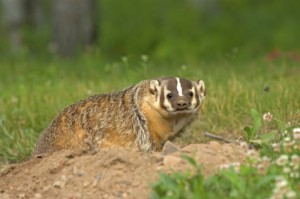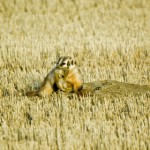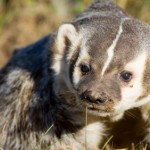Family, Description and Size:
American Badgers are large members of the family Mustelidae, which consists of various carnivorous mammals, such as the Weasel. They are short legged creatures with relatively short, fat bodies. Their heads are long with ears that look like a typical weasel’s. They have black faces with distinctive white stripes, gray bodies with a white stripe from head to tail, dark legs and a white underside. Their paws are strong and perfectly made for digging.
Large males can weigh up to 26 pounds, but the average is 20 to 24lbs. They grow to be approximately 36 inches in length, the tail included. The American Badger is generally smaller than its Eurasian cousins, but still a rather big animal compared to other Weasels.
Range and Habits:
American Badgers prefer to live in treeless areas like parkland, prairies, farmlands and grasslands, and generally anywhere they can find abundant rodent prey. They can also occur in forests, deserts and mountains.
The American Badger is a fossorial Carnivore. This means that they are adapted to live and hunt underground for prey. Its main prey is ground squirrels, pocket gophers, marmots, moles, prairie dogs, pika, woodrats, kangaroo rats, deer mice and voles. They also prey on birds that nest on the ground, such as the Sand Martin and the Burrowing Owl. They may also eat insects, skunks, honeycomb, crops, fungi and fish. Their diet is very flexible and varied contributing to their proliferation.
American Badgers are usually nocturnal, but can be seen active during the day. They do not truly hibernate, but when temperatures fall they enter a torpor they can quickly wake from when the weather briefly warms up during winter.
General Information:
While hunting ground dwelling mammals, Badgers can dig huge burrows. They can be up to 30 feet wide and ten feet deep. When this occurs extensively in range land the quality of the grassland might drop and large animals
like horses and cattle might get trapped in old burrows that have sunk. This can cause significant financial damage to farmers.
Badgers mate during late summer and early fall. The females experience what is called delayed implantation, which means that they will become pregnant months after they copulated, which is usually during December. They will have up to five young during March or April.
The young are born helpless and furless, thus depending heavily on their mother for food and safety until they are six weeks old. After that they will disperse on their own and find their own range to live in. Females will be sexually mature a year after birth.
It is interesting to note that badgers often form symbiotic relationships with coyotes, the former hunting in burrows and the latter above ground.
Predators, Mortality and Lifespan:
The American Badger is a fierce and aggressive animal so it has few predators. It usually dies of famine, disease or by the hand of humans. The young might be in danger of coyotes, bobcats and other large predators. They are on the least concern list of endangered animals and are often hunted to prevent damage.



